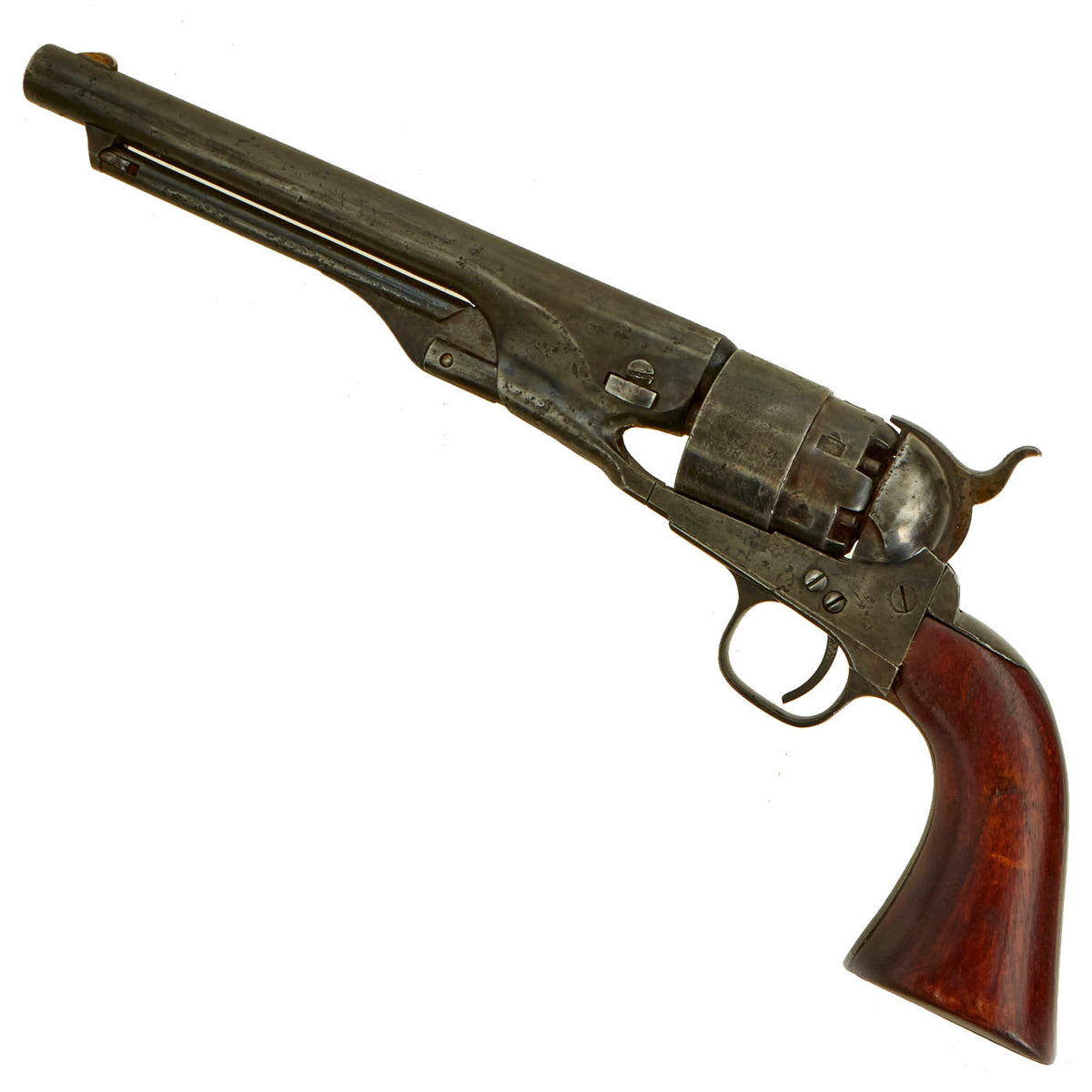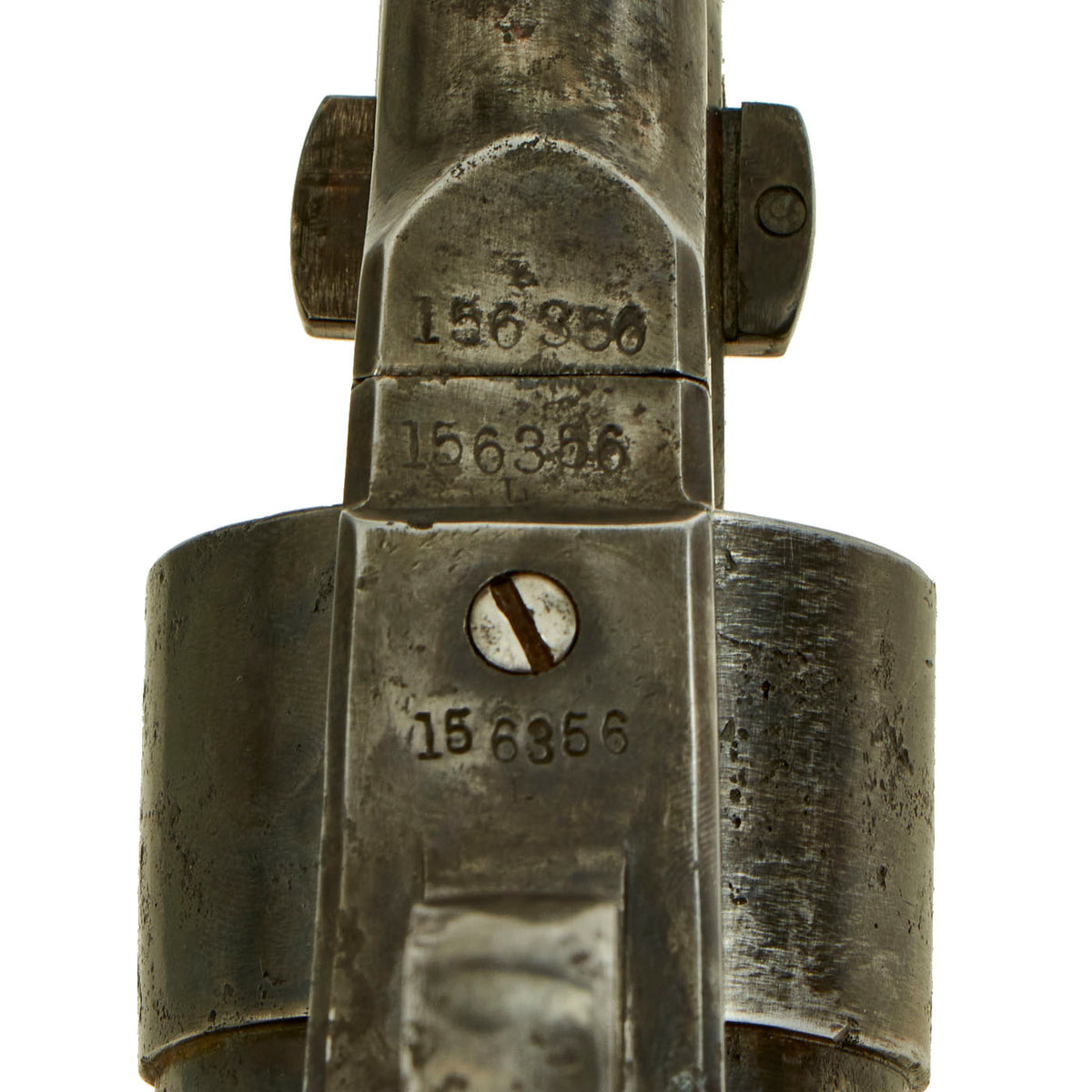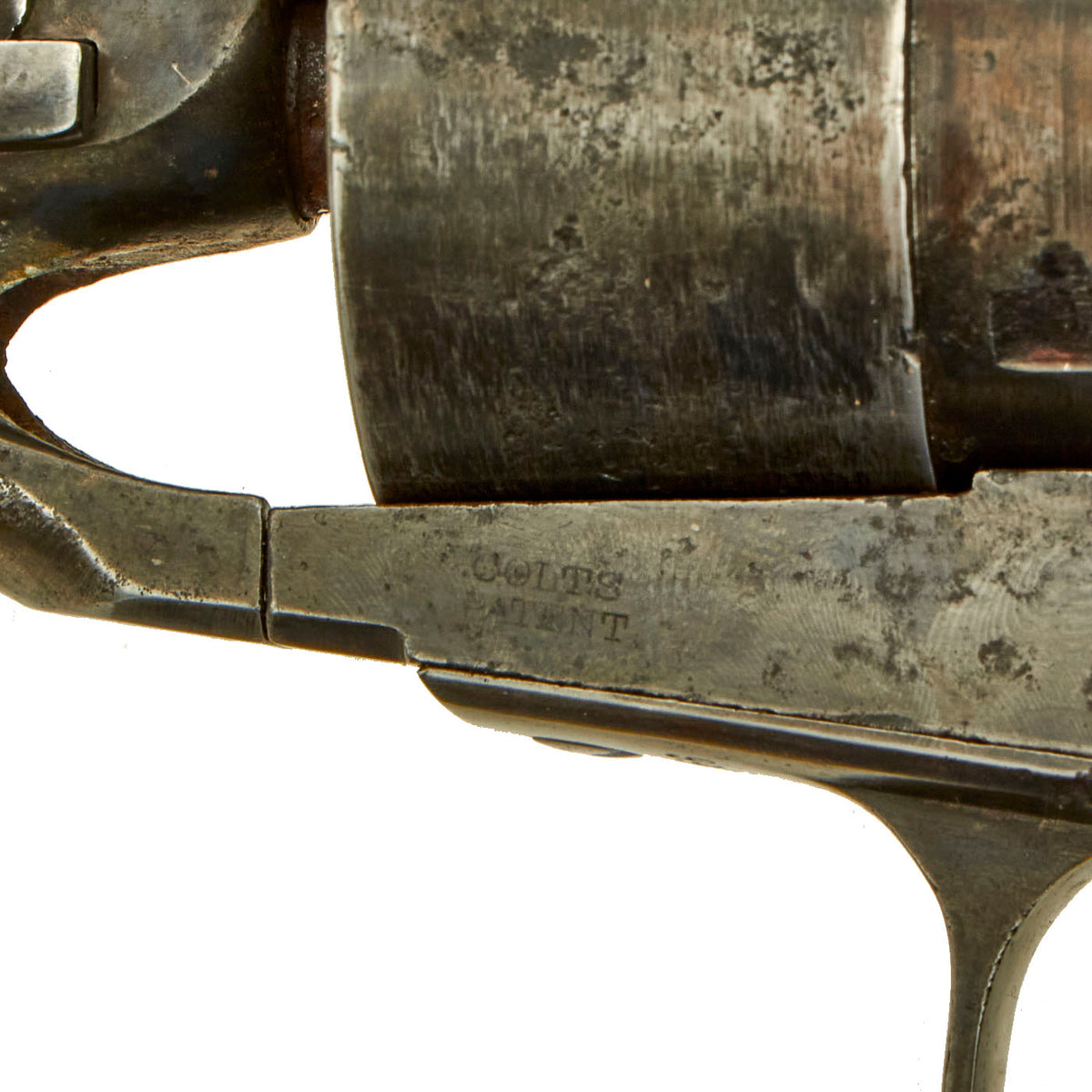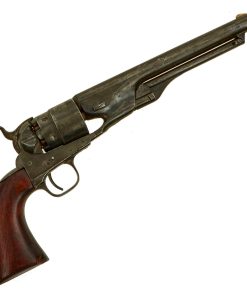Original British Proofed U.S. Colt Model 1860 Army .44cal Percussion Revolver made in 1866 – Serial No. 156356 Original Items
$ 1.995,00 $ 498,75
Original Item: Only One Available. This is a very nice .44 caliber percussion, 6 shot round cylinder, 8″ barrel Model 1860 Colt Army revolver. Gun is in very good service used condition and fully functional, with a lovely worn gray patina overall. Action and barrel frame lock up are tight, and the grip is still solidly held in the frame. Unlike most examples we see, this one was produced for the British market, and bears British proof markings on the cylinder barrel. These include the CROWN / GP “gunmakers” proof and the CROWN / V “viewed” markings from the London proof house. These are visible on the left side of the barrel, and going around the cylinder between the nipple cone inlets.
Previously Colt had built a factory in London, which opened in January 1853, however demand eventually proved insufficient, and it was closed in 1856. However they still shipped guns over on a special order basis, which usually featured steel grip frames, such as on this example. It definitely has seen a lot of use, but the Colt address marking is still faintly legible on the top of the barrel:
– ADDRESS COL. SAML COLT NEW-YORK U.S. AMERICA. –
The COLT’S PATENT marking is still fully visible on the left side of the frame, and like most we see, the “COLT’S PATENT” marking on the cylinder is gone, as well as all of the “Naval Engagement” cylinder scene.
The pistol has a nice worn oxidized finish, and does not look to have been refurbished at any time. The barrel, frame, trigger guard, and grip frame all bear matching serial number 156356, denoting year of manufacture as 1866, just after the end of the U.S. Civil War. The cylinder arbor pin is marked with shortened number 6356, and on the cylinder we can just make out a faint 635. Only the barrel wedge is an unmarked replacement, which makes this a “Mostly Matching” example.
Original walnut grips are in good condition, showing moderate wear from use, and some chipping on the front toe on the right side, which is common. The grip does not show any cracks or major damage, and has a lovely red-brown walnut color, looking to have been refinished in the past.
The pistol is complete, and functions beautifully, with crisp indexing and a strong cylinder lockup. It dry fires correctly, and has a correct “loading” position for placing the caps on the cones. The bore shows strong lands and grooves, but also fouling and oxidation from the use of corrosive black powder. Still, we see many of these shot out completely, so it is definitely above average. The barrel – frame connection is wobble free. All 6 cap nipple cones are intact and clear, though they do show some oxidation and powder burn to the exterior.
This is a very nice British Proofed example of the classic U.S. Percussion revolver, ready to display!
Specifications:
Year of Manufacture: 1866
Caliber: .44cal
Ammunition Type: Percussion Cap and Ball
Barrel Length: 8 inches
Overall Length: 14 inches
Action: Single
Feed System: 6 Shot Revolver
The Colt Army Model 1860 is a muzzle-loaded cap & ball .44-caliber revolver used during the American Civil War made by Colt’s Manufacturing Company. It was used as a side arm by cavalry, infantry, artillery troops, and naval forces.
The Colt 1860 Army uses the same size frame as the .36 caliber 1851 Navy revolver. The frame is relieved to allow the use of a rebated cylinder that enables the Army to be chambered in .44 caliber. the barrel on the 1860 Army has a forcing cone that is visibly shorter than that of the 1851 Navy, allowing the Army revolver to have a longer cylinder. Another distinguishing feature of the Colt 1860 Army, first introduced on the Colt 1855 Sidehammer Revolver, is the “creeping” loading lever.
More than 200,000 were manufactured from 1860 through 1873. Colt’s biggest customer was the US Government with no less than 129,730 units being purchased and issued to the troops. The weapon was a single-action, six-shot weapon accurate up to 75 to 100 yards, where the fixed sights were typically set when manufactured. The rear sight was a notch in the hammer, only usable when the revolver was fully cocked.
The Colt .44-caliber “Army” Model was the most widely used revolver of the Civil War. It had a six-shot, rotating cylinder, and fired a 0.454-inch-diameter (11.5 mm) round spherical lead ball, or a conical-tipped bullet, typically propelled by a 30-grain charge of black powder, which was ignited by a small copper percussion cap that contained a volatile charge of fulminate of mercury (a substance that explodes upon being subjected to a sharp impact). The percussion cap, when struck by the hammer, ignited the powder charge. When fired, balls had a muzzle velocity of about 900 feet per second (274 meters/second), although this depended on how much powder one loaded it with.
The unfluted cylinder was ‘rebated,’ meaning that the rear of the cylinder was turned to a smaller diameter than the front. The barrel was rounded and smoothed into the frame, as was the Navy Model. The frame, hammer, and rammer lever were case-hardened, the remainder blued; grips were of one-piece walnut; and the trigger guard and front grip strap were of brass while the backstrap was blued.”
A distinguishing feature of the Model 1860 was that its frame had no top strap, or no component running above the cylinder. Instead, its strength came from the lower frame and the massive fixed cylinder pin. This made the gun slimmer and lighter than its main competitor, the Remington Model 1858, but with a possible loss of strength. The fixed cylinder pin also meant that the barrel had to be removed in order to remove the cylinder, unlike the Model 1858, which only required you to remove the cylinder retaining pin.
History
By April 1861, 2,230 of Colt’s earliest production went to dealers south of the Mason-Dixon line. The United States Navy ordered 900 fluted cylinder revolvers in May 1861 later issued to ships enforcing the Atlantic and Gulf blockade. United States Army orders also began in May, and 127,157 had been delivered before a 5 October 1864 fire put Colt’s factory out of operation for the duration of hostilities.
Operation
Loading is a somewhat lengthy process, with each of the six chambers drilled into the revolving cylinder being loaded from the front, or “muzzle” end. A measured amount of black powder is poured into a chamber. Next a lead ball is placed at the opening of the chamber and seated by firmly pressing it in with the pivoting loading lever which is attached beneath the barrel of the revolver. For sealing each chamber, an over-size 0.454-inch-diameter (11.5 mm) lead ball is trimmed slightly by the rim of the chamber as the rammer forces it inside. Cap and ball shooters also often place a lubricated wad between balls and powder, or, alternatively, pack lard or a commercially-sold bore lubricant at the mouth of each chamber in an attempt to prevent powder in an adjacent chamber from being ignited by when the gun is fired, which is known as a chainfire.
When the Colt Model 1860 was used by 19th century soldiers, they most often loaded the gun using paper cartridges. These cartridges consisted of a pre-measured load of black powder and a ball, wrapped in nitrated paper (paper that had been soaked in potassium nitrate and then dried, to make it more flammable). To load each chamber, one only had to slip the cartridge into the front of the chamber and seat the ball with the loading lever ram. Then a percussion cap was placed onto the raised aperture, called a nipple, at the back end of the chamber.
The Colt 1860 cost approximately $20 per revolver. This was rather expensive during the 1860s, both for the United States Army and private citizens. Colt had been criticized by this high price, and by 1865 the revolver was reduced to $14.50.
The Colt “Army” revolver is to be distinguished from the Colt “Navy” revolver of which there were two models, the octagonal barrel Model 1851 Navy, and the round-barreled Model 1861 Navy, both Navy models being in the smaller .36-caliber.
NOTE: International orders of antique firearms MUST be shipped using UPS WW Services (courier). USPS Priority Mail international will not accept these. International customers should always consult their country’s antique gun laws prior to ordering.
Fast Shipping with Professional Packaging
Thanks to our longstanding association with UPS FedEx DHL, and other major international carriers, we are able to provide a range of shipping options. Our warehouse staff is expertly trained and will wrap your products according to our exact and precise specifications. Prior to shipping, your goods will be thoroughly examined and securely secured. We ship to thousands clients each day across multiple countries. This shows how we're dedicated to be the largest retailer on the internet. Warehouses and distribution centres can be located throughout Europe as well as the USA.
Note: Orders with more than one item will be assigned a processing date depending on the item.
Before shipping before shipping, we'll conduct a thorough inspection of the items you have ordered. Today, the majority of orders will be delivered within 48 hours. The delivery time will be between 3-7 days.
Returns
The stock is dynamic and we cannot completely manage it because multiple stakeholders are involved, including our factory and warehouse. So the actual stock may alter at any time. It's possible that you may not receive your order once the order has been made.
Our policy is valid for a period of 30 days. If you don't receive the product within 30 days, we are not able to issue a refund or an exchange.
You can only return an item if it is unused and in the same state as the day you received it. You must have the item in its original packaging.
Related products
Uncategorized
Uncategorized
Uncategorized
Uncategorized
Uncategorized
Uncategorized
Uncategorized
Uncategorized
Uncategorized
Uncategorized
Uncategorized
Armoured Fighting Vehicles of the World: AFVs of World War One (Hardcover Book) New Made Items
Uncategorized
Uncategorized
Uncategorized
Uncategorized
Australian WWII Owen MK1 Machine Carbine SMG Custom Fabricated Replica with Sling Original Items
Uncategorized
Uncategorized












































































